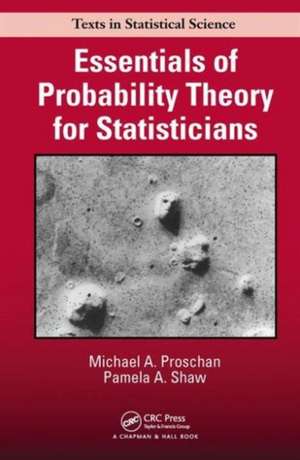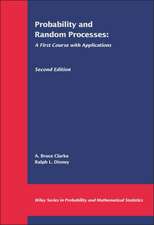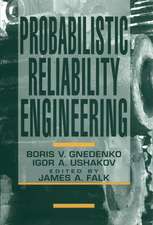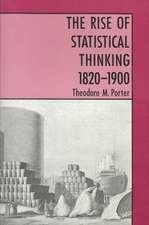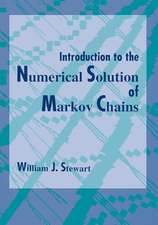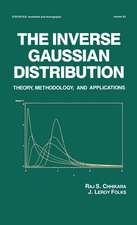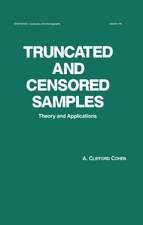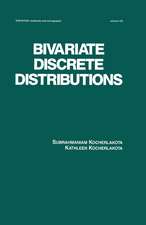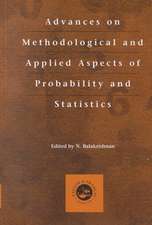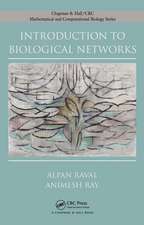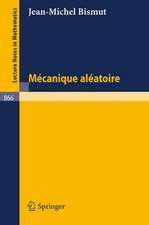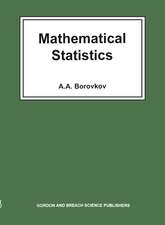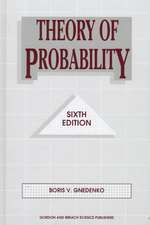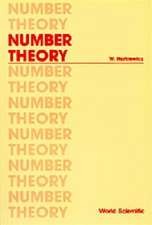Essentials of Probability Theory for Statisticians: Chapman & Hall/CRC Texts in Statistical Science
Autor Michael A. Proschan, Pamela A. Shawen Limba Engleză Hardback – 15 mar 2016
After building a foundation in probability, the text intersperses examples that make seemingly esoteric mathematical constructs more intuitive. These examples elucidate essential elements in definitions and conditions in theorems. In addition, counterexamples further clarify nuances in meaning and expose common fallacies in logic.
This text encourages students in statistics and biostatistics to think carefully about probability. It gives them the rigorous foundation necessary to provide valid proofs and avoid paradoxes and nonsensical conclusions.
| Toate formatele și edițiile | Preț | Express |
|---|---|---|
| Paperback (1) | 461.03 lei 6-8 săpt. | |
| CRC Press – 10 dec 2019 | 461.03 lei 6-8 săpt. | |
| Hardback (1) | 502.94 lei 6-8 săpt. | |
| CRC Press – 15 mar 2016 | 502.94 lei 6-8 săpt. |
Din seria Chapman & Hall/CRC Texts in Statistical Science
- 5%
 Preț: 635.71 lei
Preț: 635.71 lei - 8%
 Preț: 572.20 lei
Preț: 572.20 lei - 8%
 Preț: 548.93 lei
Preț: 548.93 lei - 5%
 Preț: 395.90 lei
Preț: 395.90 lei - 9%
 Preț: 595.00 lei
Preț: 595.00 lei - 9%
 Preț: 772.11 lei
Preț: 772.11 lei - 8%
 Preț: 544.47 lei
Preț: 544.47 lei - 9%
 Preț: 641.60 lei
Preț: 641.60 lei - 8%
 Preț: 487.35 lei
Preț: 487.35 lei - 8%
 Preț: 551.97 lei
Preț: 551.97 lei - 9%
 Preț: 1080.81 lei
Preț: 1080.81 lei - 9%
 Preț: 613.84 lei
Preț: 613.84 lei - 9%
 Preț: 609.24 lei
Preț: 609.24 lei - 9%
 Preț: 581.19 lei
Preț: 581.19 lei -
 Preț: 389.37 lei
Preț: 389.37 lei - 9%
 Preț: 578.21 lei
Preț: 578.21 lei -
 Preț: 371.71 lei
Preț: 371.71 lei - 8%
 Preț: 548.14 lei
Preț: 548.14 lei - 9%
 Preț: 602.45 lei
Preț: 602.45 lei - 9%
 Preț: 593.60 lei
Preț: 593.60 lei - 9%
 Preț: 608.07 lei
Preț: 608.07 lei - 8%
 Preț: 496.94 lei
Preț: 496.94 lei - 9%
 Preț: 610.93 lei
Preț: 610.93 lei - 20%
 Preț: 515.53 lei
Preț: 515.53 lei -
 Preț: 357.59 lei
Preț: 357.59 lei - 8%
 Preț: 495.89 lei
Preț: 495.89 lei -
 Preț: 341.42 lei
Preț: 341.42 lei - 8%
 Preț: 547.09 lei
Preț: 547.09 lei -
 Preț: 355.65 lei
Preț: 355.65 lei - 8%
 Preț: 536.31 lei
Preț: 536.31 lei - 8%
 Preț: 465.05 lei
Preț: 465.05 lei - 9%
 Preț: 617.40 lei
Preț: 617.40 lei -
 Preț: 349.09 lei
Preț: 349.09 lei - 9%
 Preț: 681.68 lei
Preț: 681.68 lei -
 Preț: 356.63 lei
Preț: 356.63 lei - 8%
 Preț: 547.27 lei
Preț: 547.27 lei - 9%
 Preț: 599.18 lei
Preț: 599.18 lei -
 Preț: 316.73 lei
Preț: 316.73 lei -
 Preț: 341.85 lei
Preț: 341.85 lei -
 Preț: 356.63 lei
Preț: 356.63 lei - 9%
 Preț: 595.90 lei
Preț: 595.90 lei - 8%
 Preț: 418.95 lei
Preț: 418.95 lei - 11%
 Preț: 686.52 lei
Preț: 686.52 lei - 8%
 Preț: 510.12 lei
Preț: 510.12 lei - 8%
 Preț: 511.06 lei
Preț: 511.06 lei - 8%
 Preț: 563.39 lei
Preț: 563.39 lei - 18%
 Preț: 713.39 lei
Preț: 713.39 lei
Preț: 502.94 lei
Preț vechi: 669.12 lei
-25% Nou
Puncte Express: 754
Preț estimativ în valută:
96.25€ • 100.36$ • 79.99£
96.25€ • 100.36$ • 79.99£
Carte tipărită la comandă
Livrare economică 20 martie-03 aprilie
Preluare comenzi: 021 569.72.76
Specificații
ISBN-13: 9781498704199
ISBN-10: 1498704190
Pagini: 344
Ilustrații: 63 black & white illustrations, 6 black & white tables
Dimensiuni: 178 x 254 x 24 mm
Greutate: 0.79 kg
Ediția:1
Editura: CRC Press
Colecția Chapman and Hall/CRC
Seria Chapman & Hall/CRC Texts in Statistical Science
ISBN-10: 1498704190
Pagini: 344
Ilustrații: 63 black & white illustrations, 6 black & white tables
Dimensiuni: 178 x 254 x 24 mm
Greutate: 0.79 kg
Ediția:1
Editura: CRC Press
Colecția Chapman and Hall/CRC
Seria Chapman & Hall/CRC Texts in Statistical Science
Cuprins
Introduction. Size Matters. The Elements of Probability Theory. Random Variables and Vectors. Integration and Expectation. Modes of Convergence. Laws of Large Numbers. Central Limit Theorems. More on Convergence in Distribution. Conditional Probability and Expectation. Applications. Appendices. Index.
Notă biografică
Michael A. Proschan is a mathematical statistician in the Biostatistics Research Branch at the U.S. National Institute of Allergy and Infectious Diseases (NIAID). A fellow of the American Statistical Association, Dr. Proschan has published more than 100 articles in numerous peer-reviewed journals. His research interests include monitoring clinical trials, adaptive methods, permutation tests, and probability. He earned a PhD in statistics from Florida State University.
Pamela A. Shaw is an assistant professor of biostatistics in the Department of Biostatistics and Epidemiology at the University of Pennsylvania Perelman School of Medicine. Dr. Shaw has published several articles in numerous peer-reviewed journals. Her research interests include methodology to address covariate and outcome measurement error, the evaluation of diagnostic tests, and the design of medical studies. She earned a PhD in biostatistics from the University of Washington.
Pamela A. Shaw is an assistant professor of biostatistics in the Department of Biostatistics and Epidemiology at the University of Pennsylvania Perelman School of Medicine. Dr. Shaw has published several articles in numerous peer-reviewed journals. Her research interests include methodology to address covariate and outcome measurement error, the evaluation of diagnostic tests, and the design of medical studies. She earned a PhD in biostatistics from the University of Washington.
Recenzii
" The book Essentials of Probability Theory for Statisticians does not try to compete with probability textbooks like Billingsley (2012) or Chung (2001), but targets a particular audience: graduate students in statistics who need to quickly learn the essentials of probability theory to make rigorous arguments in statistics. The book does not try to give a full introduction to measure theory but instead focuses on the essentials that are needed by statisticians. . . . I think that this textbook fills an important niche: It provides a concise summary of the essentials of probability theory that are needed by statisticians and at the same time relates these concepts to important applications in statistics. Hence, the reader learns to appreciate the interplay between probability and statistics. The book is well written and uses engaging language and plenty of examples and illustrations. Overall, I enjoyed teaching from this book and plan to use it again for future graduate-level teaching in statistics."
—Journal of the American Statistical Association
"This book has tremendous potential for usage in statistics and biostatistics departments where the Ph.D. students would not necessarily have taken a measure theory course but would need a rigorous treatment of probability for their dissertation research and publications in statistical and biostatistics journals … The authors are commended for providing this valuable book for students in statistics and biostatistics. The illustrative biostatistics examples (throughout chapter 10 but especially in chapter 11) provide motivating rewards for students."
—Robert Taylor, Clemson University
"… a very good textbook choice for our courses on advanced probability theory (I, II) at the graduate level."
—Jie Yang, University of Illinois at Chicago
"Many successful graduate students in statistics lack the mathematical prerequisites necessary for Billingsley’s book and find such a course too hard … The strong points of this book are a good selection of topics, good choices for proofs to include and omit, and interesting examples. Some of the examples motivate the need for mathematical theory while others illustrate the relation of the theory to statistical practice. When there is a need for it, the presentation of the material includes side explanations that should help a student with a less solid math background."
—Wlodek Byrc, University of Cincinnati
"I think the authors have done a great job at writing this book. The material is presented carefully and the examples and exercises are appropriate and extremely helpful … The strongest point of this book is the large collection of statistical applications presented along with each topic. These examples are used to motivate the need for fundamental probabilistic results. The authors have also included a great set of exercises at the end of each section. Another good idea is the summary presented at the end of each chapter. … I would be happy to adopt this book as a required text for the course that I teach; its content is appropriate and at the right level."
—Radu Herbei, Ohio State University
—Journal of the American Statistical Association
"This book has tremendous potential for usage in statistics and biostatistics departments where the Ph.D. students would not necessarily have taken a measure theory course but would need a rigorous treatment of probability for their dissertation research and publications in statistical and biostatistics journals … The authors are commended for providing this valuable book for students in statistics and biostatistics. The illustrative biostatistics examples (throughout chapter 10 but especially in chapter 11) provide motivating rewards for students."
—Robert Taylor, Clemson University
"… a very good textbook choice for our courses on advanced probability theory (I, II) at the graduate level."
—Jie Yang, University of Illinois at Chicago
"Many successful graduate students in statistics lack the mathematical prerequisites necessary for Billingsley’s book and find such a course too hard … The strong points of this book are a good selection of topics, good choices for proofs to include and omit, and interesting examples. Some of the examples motivate the need for mathematical theory while others illustrate the relation of the theory to statistical practice. When there is a need for it, the presentation of the material includes side explanations that should help a student with a less solid math background."
—Wlodek Byrc, University of Cincinnati
"I think the authors have done a great job at writing this book. The material is presented carefully and the examples and exercises are appropriate and extremely helpful … The strongest point of this book is the large collection of statistical applications presented along with each topic. These examples are used to motivate the need for fundamental probabilistic results. The authors have also included a great set of exercises at the end of each section. Another good idea is the summary presented at the end of each chapter. … I would be happy to adopt this book as a required text for the course that I teach; its content is appropriate and at the right level."
—Radu Herbei, Ohio State University
Descriere
This text provides graduate students with a rigorous treatment of probability theory, with an emphasis on results central to theoretical statistics. It presents classical probability theory motivated with illustrative examples in biostatistics, such as outlier tests, monitoring clinical trials, and using adaptive methods to make design changes based on accumulating data. In addition, counterexamples further clarify nuances in meaning and expose common fallacies in logic. The authors explain different methods of proofs and show how they are useful for establishing classic probability results.
